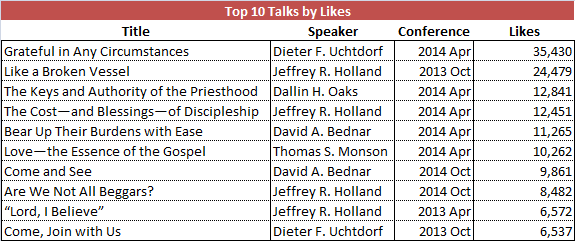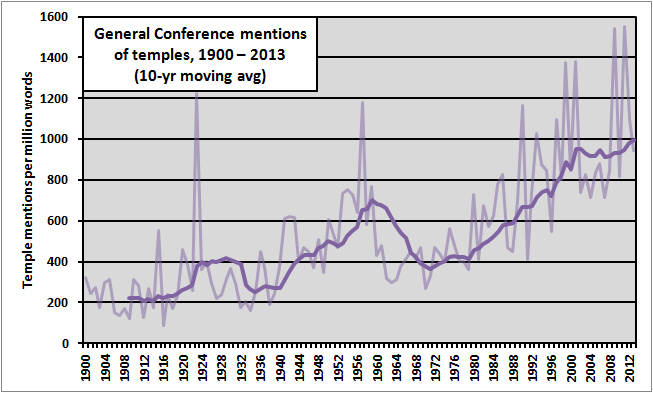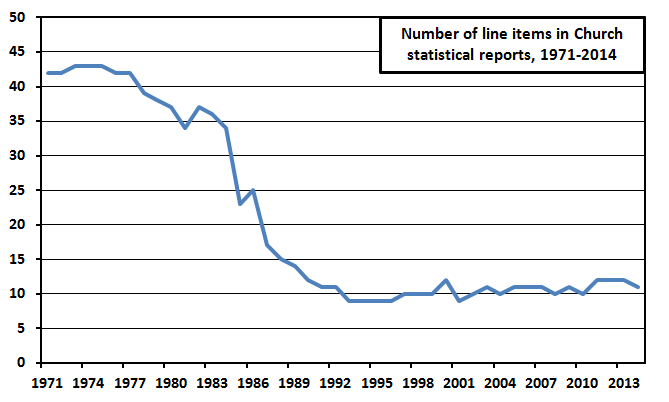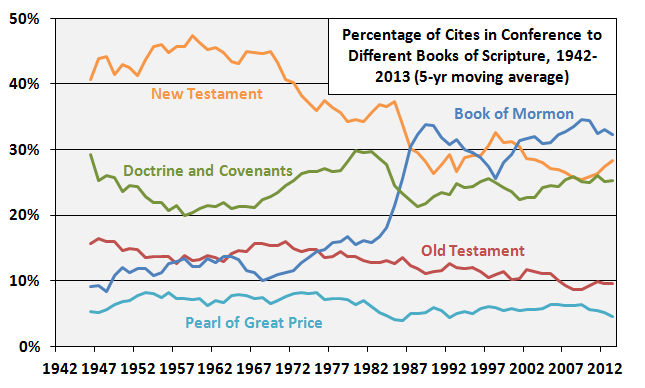Which hymns are sung most often in General Conference? My impression is that the Mormon Tabernacle Choir is always opening Conference with “The Morning Breaks,” and every other congregational hymn is “Redeemer of Israel,” but I’ve never actually looked to see if that’s true.
Showing all posts by Ziff
Nacle Notebook 2014: Funny Comments
This post is a list of some of the funniest comments I read on the Bloggernacle last year. (Here are links to collections from previous years, in case you enjoy this one and haven’t seen them before: 2013 2012 2011 2010 2009 2008.)
Most of the quotes are excerpts from longer comments. Also, I’ve made a small change from previous years: this time in addition to comments, I’ve included a few post excerpts, in cases where the excerpts can be appreciated as standalone comments. I haven’t included any of the many funny posts I’ve read that were funny end-to-end, since excerpting from such posts would mean losing the context and the full effect of the humor.
I’ve made each commenter’s name a link to the original so you can go read them in their full glory and original context if you wish. I’ve put the quotes in roughly chronological order.
Porn Preaching Patterns
In her post last week on Mormon fixation with small issues at the expense of larger more important ones, Jana Riess pointed out that the majority of all references to pornography that have ever been made in General Conference have occurred just since the turn of the millennium. I thought it might be interesting to look at the data in a little more detail, because it was my impression that discussion of porn might be declining.
I looked up the yearly rates of usage of the word “pornography” in General Conference at the LDS General Conference Corpus site. Here’s a graph showing the yearly rates and the five-year moving average. The graph starts in 1959 because that’s the first year pornography was mentioned in Conference.
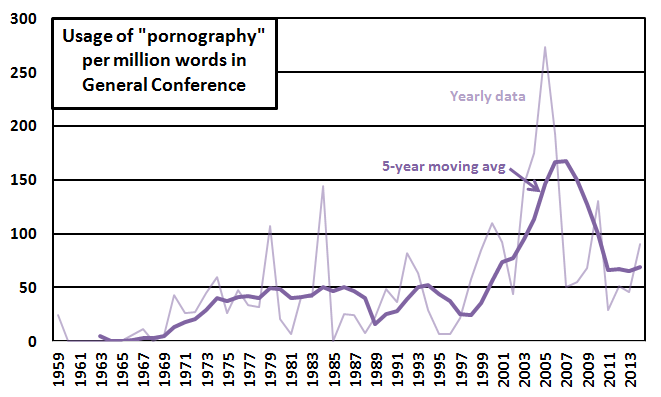 It looks like usage might have flattened out again after a big bump in the 2000s. I would guess that the big bump occurred as the internet grew and internet porn grew with it. I wonder if its usage then declined again because no one issue can be the hot topic forever. Maybe something like gay marriage took its place as the topic of the moment.
It looks like usage might have flattened out again after a big bump in the 2000s. I would guess that the big bump occurred as the internet grew and internet porn grew with it. I wonder if its usage then declined again because no one issue can be the hot topic forever. Maybe something like gay marriage took its place as the topic of the moment.
A Correlated Mormon Gender Issues Survey
It has come to the attention of the Church Correlation Department that a so-called group of so-called academics has undertaken to do a so-called survey on so-called gender issues among so-called members of the so-called Church. As internet information (including surveys) does not have a truth filter, the Correlation Department has undertaken to edit the survey so that it may be more faith promoting, and less tainted by the philosophies of (wo)men.
Please tell us a little about how you heard about this survey. Who referred you to it?
- The Holy Ghost whispered to me that I should take it.
- The Three Nephites exhorted me to take it while they were changing my flat tire.
- The spirit of a just man made perfect appeared to me and made known unto me that I must take it. I know that I was not deceived, as he refused to shake my hand.
- Other.
Of course your name is on the records of the Church of Jesus Christ of Latter-day Saints. On which other organizations’ records is your name also recorded? (Mark all that apply.)
- The Republican Party
- The Church of the Firstborn
- The Quorum of the Anointed
- The Council of Fifty
- The Lamb’s Book of Life
What is your eternal gender?
- Presider
- Nurturer
How active are you in the Church?
- Fully active
- Fully active, but struggling with being less active
Joseph’s (First) Wife, Emma
How would you describe Emma Hale’s relationship with Joseph Smith? They were married, so she was his wife. But now that the Church is being somewhat more open about Joseph’s polygamy, shouldn’t we be a little more accurate and describe Emma as Joseph’s first wife?
This question occurred to me while reading BHodges’s post at BCC where he lists a bunch of references to Joseph Smith’s polygamy in Church sources. He points out that of course he’s not listing Church source references to Emma and Joseph that do not mention Joseph’s polygamy, because they’re much more common than the references that do talk about polygamy. I thought it might be interesting to go back and look at some of these sources, though, to see if Emma is ever referred to as Joseph’s first wife. More generally, I wanted to look at these sources because even though we know in a general sense that they’re probably numerous and that they probably gloss over or ignore Joseph’s polygamy, seeing the particulars might give us a better sense of just how common they are and how much glossing and hiding they do.
Most Liked Conference Talks (Now with better data!)
I wrote a post last year in which I tried to assess which Conference talks were most liked by Church members. The method I used was very much a kludge: I looked at the change in Facebook likes for each speaker during the session in which he or she gave a talk. Fortunately, a friend pointed out to me that there’s a much simpler way to measure this. The individual web pages for each Conference talk have a count of how many people liked the talk itself on Facebook. So of course this was data that I was interested in going back to look at.
The Facebook like buttons were added to all Conference talks, going back to 1971. Beyond a couple of years ago, of course, there aren’t many likes since most old Conference talks (other than a few classics) probably aren’t referred to all that often. I might go back later and look at the older talks, but for now I was just interested in the Conferences recent enough that someone could hear a talk in Conference, and then later in the week look it up on lds.org and click like, so I limited myself to 2012 through 2014–the last six Conferences.
There are three things to note about the data. First, I got the like counts a couple of days ago, so they’re already out of date. Second, for like counts over 1,000, the like button shows a count in thousands. I got exact counts by querying Graph Search directly. (I found this on stackoverflow somewhere, but now can’t recall where. The method is to point your browser to the URL http://graph.facebook.com/?id=<URL of talk>.) Third, the like counts for the most recent Conference are lower than for previous Conferences, probably because it has only been a few weeks since Conference occurred, and people haven’t had lots of chances to re-read or re-hear a talk and go back and like it.
Here are the ten most liked talks from the past six Conferences.
The Correlated Story of Zelophehad’s Daughters
It has come to the attention of the Church Correlation Department that many of the stories told in the Bible have not passed Correlation review prior to being included in the scriptural canon. Rather than go through a lengthy and complex process of decanonization, the Correlation Department has undertaken to simply rewrite the unreviewed stories to smooth off the rough edges. The resulting stories will preserve the gospel truths present in the original, but will remove the false philosophies of men that have been inserted by evil and conspiring scribes.
Our first rewritten scripture story comes from Numbers 27.
Then came the daughters of Zelophehad to petition Moses. For their father died in the wilderness, and had no sons. They desired that Moses bring their cause before the Lord, that perhaps the inheritance of their father might pass unto them. And these are the names of the daughters of Zelophehad: Mahlah, Noah, and Hoglah, and Milcah, and Tirzah.
But Nadab spake unto them, saying, Surely Moses shall not consider such a small matter. And he turned them away.
Temple talk trends
Over at fMh yesterday, Sara Katherine Staheli Hanks introduced a new series, “When the Temple Hurts.” I was particularly interested in a point she made in the post about how often we discuss the temple in lessons and talks at church:
The temple is a regular focus of meetings, lessons, talks, and discussions in church settings. I’d estimate that, in my experience, 1 out of every 4-5 Sundays in my adult life as a church member has included a talk or lesson where the temple was a primary focus.
I’ve been teaching primary now for a couple of years, and my memory of adult classes is maybe suffering from a bit of haziness, but Sara’s numbers sound good to me. This would mean an average of at least one temple-related lesson or talk per month, with of course lots of variation where there is a cluster of them, and then maybe no mentions for a longer period of time.
I would be interested to know how well that matches up with other people’s experience. It seems like this would be a difficult thing to measure well. Sure, we have correlated lesson manuals, but we also have locally chosen topics for things like sacrament meetings, first Sunday meetings in RS and priesthood quorums, and Teachings for Our Time lessons. And for that matter, even how correlated lessons are taught varies a lot from ward to ward and from teacher to teacher (much to the frustration of the Correlation people, I’m sure).
So I thought I would look at a related question that’s easier for me to answer, which is whether talk about the temple at the general level of the Church has been increasing or decreasing over time. If there’s a noticeable change over time, this is probably felt by people in their local experiences, as general-level material like Conference talks are not only used directly in the preparation of lessons and talks, but they also likely help drive local leaders’ perceptions of what topics are important at the moment.
I used the ever-wonderful Corpus of General Conference Talks to look at how often the word temple has been used in Conference since 1900. This graph shows the result. The dark purple line is the 10-year moving average, and the faded purple line shows the year-to-year rates.
Behold! A Little Fact’ry!
It’s almost Conference time again, and although it has only been six months, I can hardly remember what was said in April. Perhaps Conference talks would be easier to remember if they were set to music. It seems appropriate to set them to the music of hymns, since Conference talks and hymns both inhabit that space of being sorta kinda but not really completely scripture.
I’ll start with an easy one. Here’s a singable version of then-Elder Boyd K. Packer’s classic “To Young Men Only,” given in the Priesthood Session of October 1976 Conference. Sing to the tune of “Behold! A Royal Army.”
Behold! A little fact’ry
Is in you; it begins
To make a sacred substance,
But opens you to sins.
Your fact’ry will run slowly,
And when it makes too much,
It opens a release valve:
This valve you must not touch!
Tamper not! Tamper not!
Do not touch that release valve!
Tamper not! Tamper not!
If tempted, sing a hymn!
Tamper not! Tamper not! Tamper not!
Your fact’ry lights keep dim.
The Incredible Shrinking Statistical Report
If you look back through Church statistical reports released in every April Conference (and who hasn’t?), you find that it’s not exactly the same information that gets reported each year. I don’t mean that the numbers change; I mean that which categories of numbers even get reported change. There has been less change in recent years, but if you look back to the 80s, you’ll find lots of categories of information that used to be reported that aren’t anymore. For example, you’ll find number of babies blessed (last reported in 1988), number of boys and men who hold different priesthood offices (1986), number of proxy temple ordinances (1984), marriage rate (1983), and number of women in the Relief Society (1977).
I thought it might be interesting to look at what categories of information have been reported in statistical reports at different times, as well as how many total categories of information have been reported. This first graph shows how many line items (separate numbers representing different pieces of information) were in the statistical report each year from 1971 to 2014.
This graph shows the number of line items in the statistical report each year from 1971 to 2014.
Do women’s patriarchal blessings mention a career?
Several months ago (in May, I think), there was a discussion at the Mormon Hub that turned to whether women’s patriarchal blessings mentioned a career or not. Heather (who blogs at Doves and Serpents) and I thought it would be interesting to see if we could get a little data on the question. Heather put together a brief survey, and we asked for responses in the Hub and in the fMh Facebook group. For purposes of comparison, we asked for men to respond too, although we got far more responses from women.
We got a total of 422 responses (actually slightly more, but a few were incomplete and couldn’t be included): 359 from women, and 63 from men. The years they reported receiving their patriarchal blessings ranged from 1941 to 2013.
This graph shows overall results, ignoring year of the blessing:
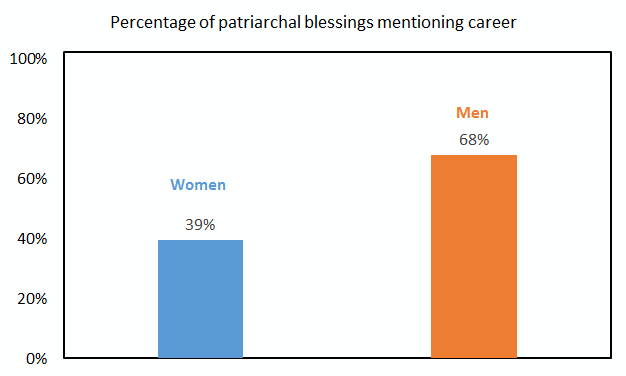 Not surprisingly, patriarchs mentioned career far more often for men than they did for women.
Not surprisingly, patriarchs mentioned career far more often for men than they did for women.
We don’t need no stinkin’ dictionary!
This is an exchange between Jane Little and Michael Otterson in Little’s BBC piece “Sister Saints – Women and the Mormons” (starting at about 11:20; also see the accompanying article here):
JL: Just to deal with Kate Kelly, just to clarify, was she excommunicated for apostasy?
MO: The letter that went out, that they actually published on their website, briefly, at least they released it to the media, indicated that the reason why that disciplinary action was taken was for apostasy. I’m not sure it actually used the word, but apostasy is seen as repeated and deliberate advocating to doctrines contrary to the Church, especially encouraging other people to take the same position.
JL: So you would say she is an apostate, under that definition?
MO: Yeah.
JL: The dictionary definition says it’s renouncing your faith, which is somewhat different.
MO: Well, I don’t think I[‘m] particularly obligated to worry about what it says in Oxford or Merriam-Webster’s Dictionary. Our definition of apostasy is repeated open advocacy of doctrines contrary to the Church.
It’s not surprising that Otterson would want to use an unconventional definition of apostasy. It allows him to use a more serious-sounding word than “insufficient submissiveness in the face of leaders’ demands” in explaining why Kate Kelly had to be kicked out. I realize, of course, that he was taking his definition from the Handbook, but that just means it’s the Church leaders who wrote or commissioned the Handbook who are making up a new definition to allow them to borrow strength from an existing weighty word.
Insider/outsider language in President Hinckley’s "there’s no agitation" statement
In a 1997 interview with Australian reporter David Ransom, President Hinckley said that there was “no agitation” for women to receive the priesthood. Ordain Women cites this comment in their FAQ as a motivation for agitating for ordination. (Dane Laverty also earlier cited this comment as his rationale for his similar project, Agitating Faithfully.)
I’ve seen some argument in the Bloggernacle about what President Hinckley meant when he said this. OW’s FAQ calls it a “challenge” to agitate. Opponents of OW have responded that of course he didn’t mean that he wanted people to agitate for ending the female priesthood ban. He was just pointing out a simple fact: nobody was agitating.
I think a useful way to think about this argument is to consider President Hinckley’s comment in the framework of insider language versus outsider language. Read More
A So-called "Post"
In Angela C.’s hilarious post “Mormon Jargon 2” at BCC, this is her entry for “so-called”:
So-called (adj.) I sneer at whatever word follows this adjective
It seems like this is a term GAs use fairly often to indicate disapproval, as Angela observes. Elder Oaks, for example, last October, used it at least a couple of times (maybe even three?) in his talk “No Other Gods” (although only one occurrence made it into the written version). I thought it might be interesting to look back at who uses “so-called” most often, what they’re disapproving of, and whether there is any trend over time in its usage.
Which GAs Do Readers of Different Blogs Like?
I thought this might be a fun question to look at, and thanks to Facebook’s Graph Search, I have at least an approximate way to answer it. Graph Search will let you look for people who “like” different combinations of pages. (For the remainder of this post, I’m going to drop the quotation marks on “like” when describing Facebook likes, because they just get tiring to look at, and I figure you know what I’m talking about.) Most blogs that I wanted to look at have a Facebook page that readers can like, so I just looked up people who liked the Facebook page for each blog, and then looked at how many of each of these people liked each member of the Quorum of 15. One small difficulty I encountered is that Graph Search is more interested in showing me individual people than in giving me an exact count (which makes sense given what Facebook is for). It estimates the number of people who like a blog page and a GA page as more than 10, or fewer than 1000, or whatever, but I couldn’t get an exact count without repeatedly scrolling to the bottom of the results so that it would pull up even more results until it could find no more.
One thing I wanted to adjust for is that the general membership of the Church likes different Q15 members more or less often on Facebook (as I’ve blogged about before and plan to again). So I thought it would be most interesting to see which Q15 members are most liked by readers of different blogs, compared to how often the GAs are liked overall. For example, President Monson alone accounts for nearly 20% of all likes of Q15 members. If he gets only 15% of likes given to Q15 members by readers of a particular blog, this indicates he’s less popular among readers of the blog than among members in general (even if he still gets more likes than any other Q15 member from readers of the blog).
Here are results for ZD. The differences are in percentage points (the percentage of all likes of Q15 members going to this member among likers of the blog minus the same calculation for all Facebook users). I put the First Presidency at the left because a lot of the action is there, and then put the Q12 in order of seniority. Note that I’ve added the colors just to make it easier to see who is who at a glance. A lot of these graphs look similar, so I think it can be helpful to have the colors so you can easily look for the same person as you look across graphs.
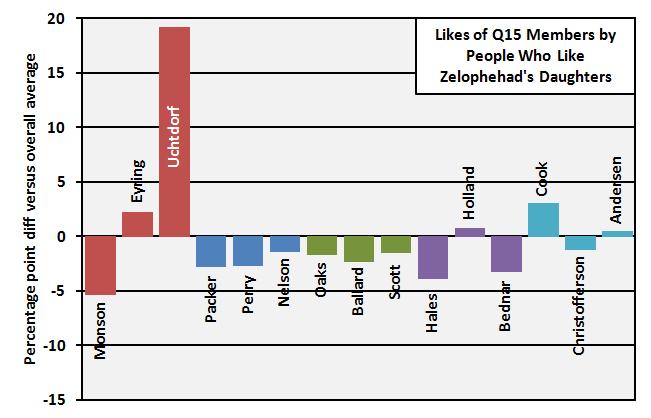 Well, that’s a pretty straightforward pattern. ZD readers like President Uchtdorf. They really, really like him. Most everyone else falls below overall norms to compensate.
Well, that’s a pretty straightforward pattern. ZD readers like President Uchtdorf. They really, really like him. Most everyone else falls below overall norms to compensate.
Which RS/YW/Primary Presidency Members Prefer Which Books of Scripture?
I blogged a few days ago about which books of scripture Quorum of 15 members cite more or less frequency in Conference. BethSmash asked to see results for women leaders.
Unfortunately, getting trends over time for the women leaders requires more work than I have the energy for right now. I would need to get not only distribution of citations by book of scripture for each person, but for each person in each year. Sorry, BethSmash! But I did get counts of citations for each person ignoring when the talk was given, and I’ve done the same adjustment I did for the Quorum of 15 members in the other post, adjusting for the prevailing citation norms at the times the people were in their callings. I’ve put these in this post, in case they’re of any interest.
I looked in the LDSSCI for citation counts for all members of a Relief Society, Young Women’s, or Primary General Presidency since the mid-1970s. I didn’t look back any further because if I remember right, women didn’t speak regularly in Conference before the 1980s, and there weren’t General Women’s meetings (which the LDSSCI includes) before the late 1970s.
Here are counts for all RS, YW, and Primary Presidency members who had at least 10 scripture citations in their talks (regardless of how many talks it took them to use that many references). There are 42 women who meet this criterion. I’ve put them in order by calling year.
Which GAs Prefer Which Books of Scripture? (Supplemental material)
This post has some supplemental graphs for the post “Which GAs Prefer Which Books of Scripture?”
Which GAs Prefer Which Books of Scripture?
Thanks to the handy LDS Scripture Citation Index (LDSSCI), it’s easy to get data to answer this question. I looked up each of the current members of the Quorum of 15 to see how often he cited the Old Testament, New Testament, Book of Mormon, Doctrine and Covenants, and Pearl of Great Price in his Conference talks. For example, for President Monson, the counts are 332, 818, 184, 255, and 32, respectively. Here are counts for all Quorum members:
| Counts | ||||||
|---|---|---|---|---|---|---|
| Member | OT | NT | BoM | D&C | PGP | Total |
| Monson | 332 | 818 | 184 | 255 | 32 | 1621 |
| Packer | 125 | 312 | 559 | 470 | 96 | 1562 |
| Perry | 95 | 116 | 141 | 106 | 74 | 532 |
| Nelson | 399 | 695 | 910 | 945 | 209 | 3158 |
| Oaks | 149 | 538 | 504 | 386 | 60 | 1637 |
| Ballard | 26 | 139 | 133 | 111 | 32 | 441 |
| Scott | 25 | 57 | 203 | 144 | 34 | 463 |
| Hales | 77 | 336 | 291 | 187 | 78 | 969 |
| Holland | 70 | 243 | 140 | 74 | 24 | 551 |
| Eyring | 27 | 97 | 162 | 135 | 16 | 437 |
| Uchtdorf | 56 | 166 | 126 | 121 | 28 | 497 |
| Bednar | 19 | 60 | 148 | 87 | 15 | 329 |
| Cook | 27 | 57 | 73 | 82 | 9 | 248 |
| Christofferson | 11 | 129 | 139 | 118 | 26 | 423 |
| Andersen | 17 | 98 | 102 | 59 | 11 | 287 |
Next, to adjust for the fact that Quorum members differ in the total number of scripture citations they put in their talks, I converted the counts of citations to percentages of all citations by the member. Using President Monson as an example again, this means dividing each of his counts by book (332, 818, 184, 255, and 32) by his total (1621) to get his percentages. Here are percentages for all Quorum members:
| Percentages | ||||||
|---|---|---|---|---|---|---|
| Member | OT | NT | BoM | D&C | PGP | |
| Monson | 20% | 50% | 11% | 16% | 2% | |
| Packer | 8% | 20% | 36% | 30% | 6% | |
| Perry | 18% | 22% | 27% | 20% | 14% | |
| Nelson | 13% | 22% | 29% | 30% | 7% | |
| Oaks | 9% | 33% | 31% | 24% | 4% | |
| Ballard | 6% | 32% | 30% | 25% | 7% | |
| Scott | 5% | 12% | 44% | 31% | 7% | |
| Hales | 8% | 35% | 30% | 19% | 8% | |
| Holland | 13% | 44% | 25% | 13% | 4% | |
| Eyring | 6% | 22% | 37% | 31% | 4% | |
| Uchtdorf | 11% | 33% | 25% | 24% | 6% | |
| Bednar | 6% | 18% | 45% | 26% | 5% | |
| Cook | 11% | 23% | 29% | 33% | 4% | |
| Christofferson | 3% | 30% | 33% | 28% | 6% | |
| Andersen | 6% | 34% | 36% | 21% | 4% | |
(Note that the percentages do not add to 100 for some members because of rounding.)
Finally, I did one more adjustment to account for the norms of how often the different books of scripture are cited in Conference by all speakers during the years each Quorum member served. What I mean here is that at different points in time, different books of scripture were cited more or less by all speakers in Conference. Because members have been in the Quorum for different amounts of time, some of the differences between them can be accounted for by the different norms in Conference at the times they were giving talks.
The biggest shift in the time current Quorum members have served has been an increase in citations of the Book of Mormon. Here’s a graph showing the percentage of all citations of scriptures in Conference that came from each of the five books of scripture since 1942 (as far back as the LDSSCI has Conference talk data).
When will the female priesthood ban end?
Monday was a terrible, horrible, no good, very bad day. I was actually surprised at how badly I took the news of Kate Kelly’s excommunication. When I heard about it, I just felt sick, and even my usual coping strategy of information-seeking didn’t work very well. Every Facebook post and news story I read just made me feel sicker and want to cry more. I had expected beforehand that excommunication would be the outcome. Or at least I told myself that I was expecting it. Given how difficult hearing the actual news was for me, though, I guess I had been holding out more hope than I realized that the outcome would be something else–anything else.
But that was Monday. Today, I’m trying to think about the future, specifically, the future of the LDS female priesthood ban. I really believe that it will one day be lifted. I just have no idea when. But because I find it soothing to crunch numbers and speculate, I’ve gone ahead and done that in this post. I realize, though, that this is little more than guessing.
Nine Ways OW Could Have Actually Protested at Conference
Since the news broke that Kate Kelly is facing Church discipline, I’ve seen a number of people argue that she must have known she had it coming after she organized those public protests at Conference. I know this has been argued before, but I think it’s pretty obvious that the Ordain Women actions at the last two Conferences don’t qualify as protests by any reasonable stretch of the term. A protest is about opposing something. The OW actions were about asking for inclusion in something. They’re actually complete opposites to protests in terms of their starting assumptions: you protest things you think are bad; you ask to be included in things you think are good. OW was affirming the goodness of priesthood session, just like they’ve affirming the authority of the Quorum of 15 by asking them to ask God about ending the female priesthood ban.
I can see how people decide that the OW actions were protests, though. The problem, I think, is that we belong to a church that emphasizes obedience, conformity, and deference to authority so much. I mean, you can get people to look at you like you’re an alien by simply voting “opposed” on someone’s calling in sacrament meeting. You can get people to gasp in Sunday School (or elders quorum, or, I’m guessing, in Relief Society) by merely starting a comment with “I disagree.” It’s understandable, in a culture such as this, for an action even as mild and respectful as OW’s to make people deeply uncomfortable. I’m not surprised, then, that they reach for an inappropriately harsh word to try to describe it.
